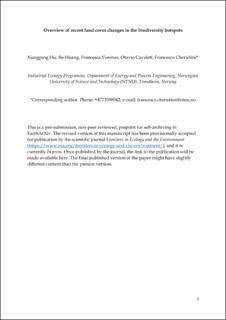| dc.contributor.author | Hu, Xiangping | |
| dc.contributor.author | Huang, Bo | |
| dc.contributor.author | Verones, Francesca | |
| dc.contributor.author | Cavalett, Otávio | |
| dc.contributor.author | Cherubini, Francesco | |
| dc.date.accessioned | 2021-03-24T07:41:05Z | |
| dc.date.available | 2021-03-24T07:41:05Z | |
| dc.date.created | 2020-10-29T21:49:04Z | |
| dc.date.issued | 2020 | |
| dc.identifier.citation | Frontiers in Ecology and the Environment. 2020, . | en_US |
| dc.identifier.issn | 1540-9295 | |
| dc.identifier.uri | https://hdl.handle.net/11250/2735199 | |
| dc.description.abstract | Between 1992 and 2015, nearly 148 million hectares (Mha) within biodiversity hotspots – biologically rich but threatened terrestrial regions – worldwide underwent land‐cover changes, equating to 6% of the total areal extent of hotspots. Forest losses in hotspots amounted to 54 Mha (–7% of the forest area present in 1992), driven primarily by agricultural expansion (38 Mha); shrubland or savanna also declined by 23 Mha (–8%). Over the same time, urban areas expanded by 10 Mha (+108%). Major losses in forest areas occurred in Sundaland (11 Mha, –13% relative to 1992), Indo‐Burma (6 Mha, –6%), and Mesoamerica (5 Mha, –7%). Approximately 7.5 Mha of forest loss occurred within protected areas (–5% of the respective forest area in 1992), of which 3.9 Mha was cleared between 2000 and 2015, with ~1 Mha alone converted in the 5 years after 2010. More stringent and effective land‐based policies are urgently needed to prevent additional landscape fragmentation and preserve existing species richness in the world's biodiversity hotspots. | en_US |
| dc.language.iso | eng | en_US |
| dc.publisher | Ecological Society of America | en_US |
| dc.title | Overview of recent land‐cover changes in biodiversity hotspots | en_US |
| dc.type | Journal article | en_US |
| dc.type | Peer reviewed | en_US |
| dc.description.version | acceptedVersion | en_US |
| dc.source.pagenumber | 7 | en_US |
| dc.source.journal | Frontiers in Ecology and the Environment | en_US |
| dc.identifier.doi | 10.1002/fee.2276 | |
| dc.identifier.cristin | 1843402 | |
| dc.relation.project | Norges forskningsråd: 286773 | en_US |
| dc.description.localcode | (c) Copyright by the Ecological Society of America | en_US |
| cristin.ispublished | true | |
| cristin.fulltext | postprint | |
| cristin.qualitycode | 2 | |
